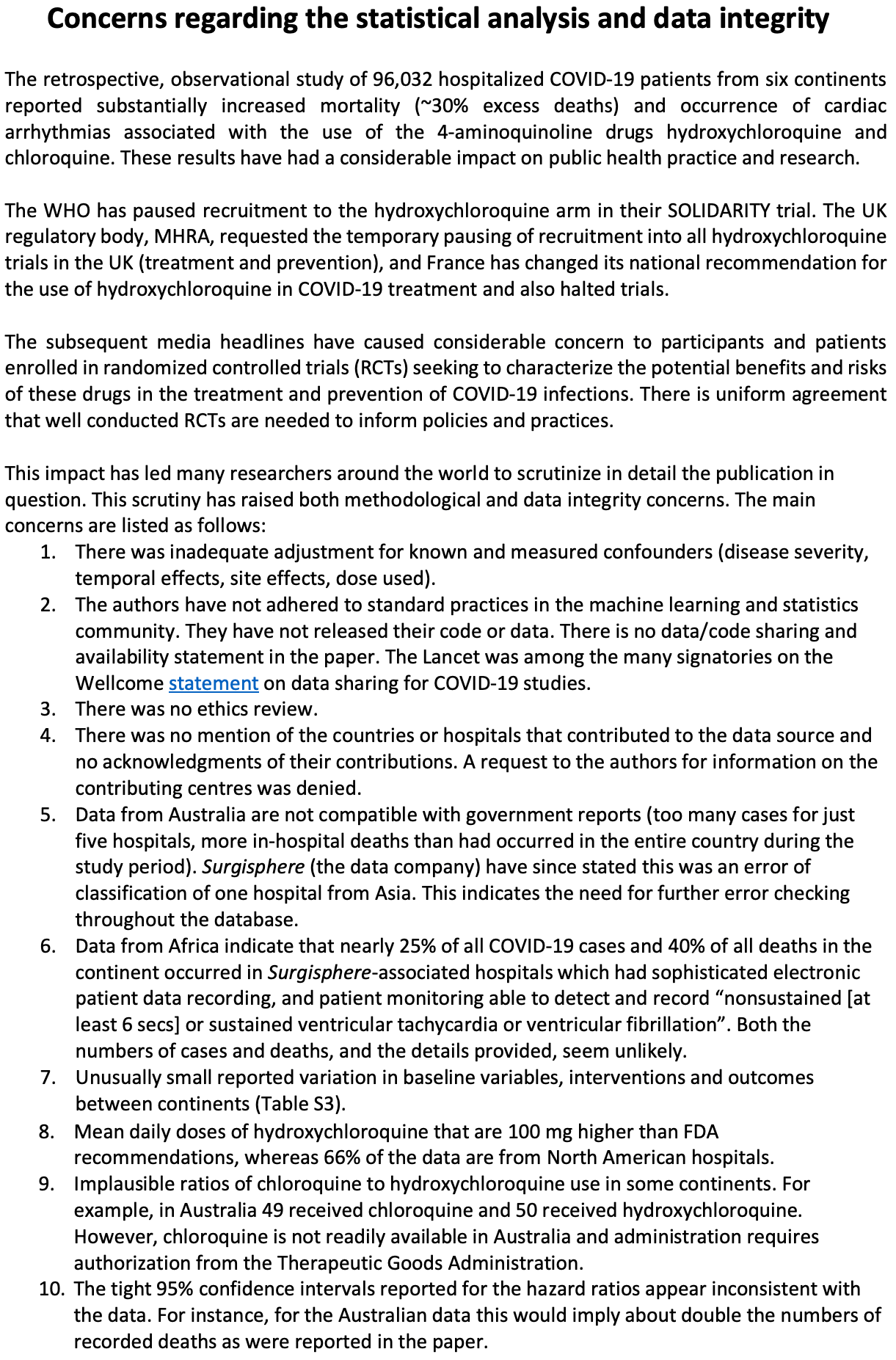RETRACTED: Hydroxychloroquine or chloroquine with or without a macrolide for treatment of COVID-19: a multinational registry analysis
Prof Mandeep R Mehra, Sapan S Desai, Prof Frank Ruschitzka, Amit N Patel
The Lancet, doi:10.1016/s0140-6736(20)31180-6
Background Hydroxychloroquine or chloroquine, often in combination with a second-generation macrolide, are being widely used for treatment of COVID-19, despite no conclusive evidence of their benefit. Although generally safe when used for approved indications such as autoimmune disease or malaria, the safety and benefit of these treatment regimens are poorly evaluated in COVID-19.
Methods We did a multinational registry analysis of the use of hydroxychloroquine or chloroquine with or without a macrolide for treatment of COVID-19. The registry comprised data from 671 hospitals in six continents. We included patients hospitalised between Dec 20, 2019, and April 14, 2020, with a positive laboratory finding for SARS-CoV-2. Patients who received one of the treatments of interest within 48 h of diagnosis were included in one of four treatment groups (chloroquine alone, chloroquine with a macrolide, hydroxychloroquine alone, or hydroxychloroquine with a macrolide), and patients who received none of these treatments formed the control group. Patients for whom one of the treatments of interest was initiated more than 48 h after diagnosis or while they were on mechanical ventilation, as well as patients who received remdesivir, were excluded. The main outcomes of interest were in-hospital mortality and the occurrence of de-novo ventricular arrhythmias (non-sustained or sustained ventricular tachycardia or ventricular fibrillation). Findings 96 032 patients (mean age 53•8 years, 46•3% women) with COVID-19 were hospitalised during the study period and met the inclusion criteria. Of these, 14 888 patients were in the treatment groups (1868 received chloroquine, 3783 received chloroquine with a macrolide, 3016 received hydroxychloroquine, and 6221 received hydroxychloroquine with a macrolide) and 81 144 patients were in the control group. 10 698 (11•1%) patients died in hospital. After controlling for multiple confounding factors (age, sex, race or ethnicity, body-mass index, underlying cardiovascular disease and its risk factors, diabetes, underlying lung disease, smoking, immunosuppressed condition, and baseline disease severity), when compared with mortality in the control group (9•3%), hydroxychloroquine (18•0%; hazard ratio 1•335, 95% CI 1•223-1•457), hydroxychloroquine with a macrolide (23•8%; 1•447, 1•368-1•531), chloroquine (16•4%; 1•365, 1•218-1•531), and chloroquine with a macrolide (22•2%; 1•368, 1•273-1•469) were each independently associated with an increased risk of in-hospital mortality. Compared with the control group (0•3%), hydroxychloroquine (6•1%; 2•369, 1•935-2•900), hydroxy chloroquine with a macrolide (8•1%; 5•106, 4•106-5•983), chloroquine (4•3%; 3•561, 2•760-4•596), and chloroquine with a macrolide (6•5%; 4•011, 3•344-4•812) were independently associated with an increased risk of de-novo ventricular arrhythmia during hospitalisation. Interpretation We were unable to confirm a benefit of hydroxychloroquine or chloroquine, when used..
R E T R A C T E D
References
Bonow, Fonarow, Gara, Yancy, Association of coronavirus disease 2019 (COVID-19) with myocardial injury and mortality, JAMA Cardiol,
doi:10.1001/jamacardio.2020.1105Borba, Val, Sampaio, Effect of high vs low doses of chloroquine diphosphate as adjunctive therapy for patients hospitalized with severe acute respiratory syndrome coronavirus 2 (SARS-CoV-2) infection: a randomized clinical trial, JAMA Netw Open
Chen, Liu, Liu, A pilot study of hydroxychloroquine in treatment of patients with moderate COVID-19
Devaux, Rolain, Colson, Raoult, New insights on the antiviral effects of chloroquine against coronavirus: what to expect for COVID-19?, Int J Antimicrob Agents,
doi:10.1016/j.ijantimicag.2020.105938Gao, Tian, Yang, Breakthrough: chloroquine phosphate has shown apparent efficacy in treatment of COVID-19 associated pneumonia in clinical studies, Biosci Trends
Gautret, Lagier, Parola, Hydroxychloroquine and azithromycin as a treatment of COVID-19: results of an open-label non-randomized clinical trial, Int J Antimicrob Agents
Giudicessi, Noseworthy, Friedman, Ackerman, Urgent guidance for navigating and circumventing the QTc-prolonging and torsadogenic potential of possible pharmacotherapies for coronavirus disease
Guo, Fan, Chen, Cardiovascular implications of fatal outcomes of patients with coronavirus disease 2019 (COVID-19), JAMA Cardiol,
doi:10.1001/jamacardio.2020.1017Icu=intensive, care unit. *Macrolides include only clarithromycin and azithromycin. References 1 Principi N, Esposito S. Chloroquine or hydroxychloroquine for prophylaxis of COVID-19,
doi:10.1016/S1473-3099(20)30296-6Lavie, Arena, Alpert, Milani, Ventura, Management of cardiovascular diseases in patients with obesity, Nat Rev Cardiol
Lee, Wong, Chan, Anti-inflammatory effects of adjunctive macrolide treatment in adults hospitalized with influenza: a randomized controlled trial, Antiviral Res
Liu, Cao, Xu, Hydroxychloroquine, a less toxic derivative of chloroquine, is effective in inhibiting SARS-CoV-2 infection in vitro, Cell Discov
Magagnoli, Narendran, Pereira, Outcomes of hydroxychloroquine usage in United States veterans hospitalized with COVID-19, medRxiv,
doi:10.1101/2020.04.16.20065920Mahevas, Tran, Roumier, No evidence of clinical efficacy of hydroxychloroquine in patients hospitalised for COVID-19 infection with oxygen requiremenr: results of a study using routinely collected data to emulate a target trial, medRxiv,
doi:10.1101/2020.04.10.20060699Mehra, Desai, Kuy, Henry, Patel, Cardiovascular disease, drug therapy, and mortality in COVID-19, N Engl J Med,
doi:10.1056/NEJMoa2007621Mercuro, Yen, Shim, Risk of QT interval prolongation associated with use of hydroxychloroquine with or without concomitant azithromycin among hospitalized patients testing positive for coronavirus disease 2019 (COVID-19), JAMA Cardiol,
doi:10.1001/jamacardio.2020.1834Nakornchai, Konthiang, Activity of azithromycin or erythromycin in combination with antimalarial drugs against multidrug-resistant Plasmodium falciparum in vitro, Acta Trop
Peschken, Possible consequences of a shortage of hydroxychloroquine for patients with systemic lupus erythematosus amid the COVID-19 pandemic, J Rheumatol,
doi:10.3899/jrheum.200395Ray, Murray, Hall, Arbogast, Stein, Azithromycin and the risk of cardiovascular death, N Engl J Med
Sanchis-Gomar, Lavie, Mehra, Henry, Lippi, Obesity and outcomes in COVID-19: when an epidemic and pandemic collide, Mayo Clin Proc,
doi:10.1016/j.mayocp.2020.05.006Shi, Qin, Shen, Association of cardiac injury with mortality in hospitalized patients with COVID-19 in Wuhan, China, JAMA Cardiol,
doi:10.1001/jamacardio.2020.0950Siddiqi, Mehra, COVID-19 illness in native and immunosuppressed states: a clinical-therapeutic staging proposal, J Heart Lung Transplant
Tang, Cao, Han, Hydroxychloroquine in patients mainly with mild to moderate COVID-19: an open-label, randomized, controlled trial,
doi:10.1101/2020.04.10.20060558Traebert, Dumotier, Meister, Hoffmann, Dominguez-Estevez et al., Inhibition of hERG K+ currents by antimalarial drugs in stably transfected HEK293 cells, Eur J Pharmacol
Varga, Flammer, Steiger, Endothelial cell infection and endotheliitis in COVID-19, Lancet
Who, Clinical management of severe acute respiratory infection (SARI) when novel COVID-19 disease is suspected: interim guidance
